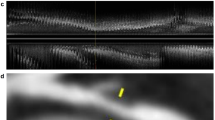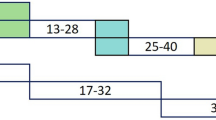Abstract
Objectives
Coronary computed tomography angiography (CCTA) has rapidly developed in the coronary artery disease (CAD) field. However, manual coronary artery tree segmentation and reconstruction are time-consuming and tedious. Deep learning algorithms have been successfully developed for medical image analysis to process extensive data. Thus, we aimed to develop a deep learning tool for automatic coronary artery reconstruction and an automated CAD diagnosis model based on a large, single-centre retrospective CCTA cohort.
Methods
Automatic CAD diagnosis consists of two subtasks. One is a segmentation task, which aims to extract the region of interest (ROI) from original images with U-Net. The second task is an identification task, which we implemented using 3DNet. The coronary artery tree images and clinical parameters were input into 3DNet, and the CAD diagnosis result was output.
Results
We built a coronary artery segmentation model based on CCTA images with the corresponding labelling. The segmentation model had a mean Dice value of 0.771 ± 0.021. Based on this model, we built an automated diagnosis model (classification model) for CAD. The average accuracy and area under the receiver operating characteristic curve (AUC) were 0.750 ± 0.056 and 0.737, respectively.
Conclusion
Herein, using a deep learning algorithm, we realized the rapid classification and diagnosis of CAD from CCTA images in two steps. Our deep learning model can automatically segment the coronary artery quickly and accurately and can deliver a diagnosis of ≥ 50% coronary artery stenosis. Artificial intelligence methods such as deep learning have the potential to elevate the efficiency in CCTA image analysis considerably.
Key Points
• The deep learning model rapidly achieved a high Dice value (0.771 ± 0.0210) in the autosegmentation of coronary arteries using CCTA images.
• Based on the segmentation model, we built a CAD autoclassifier with the 3DNet algorithm, which achieved a good diagnostic performance (AUC) of 0.737.
• The deep neural network could be used in the image postprocessing of coronary computed tomography angiography to achieve a quick and accurate diagnosis of CAD.



Similar content being viewed by others
Abbreviations
- AUC:
-
Area under the curve
- BP:
-
Backpropagation
- CAD:
-
Coronary artery disease
- CAD-RADS:
-
Coronary Artery Disease Reporting and Data System
- CCTA:
-
Coronary computed tomography angiography
- DSC:
-
Dice similarity coefficient
- PPV:
-
Positive predictive value
- ROI:
-
Region of interest
- SCCT:
-
Society of Cardiovascular Computed Tomography
- SD:
-
Standard deviation
- TPVF:
-
True positive volume fraction
References
Joseph P, Leong D, McKee M et al (2017) Reducing the global burden of cardiovascular disease, part 1: the epidemiology and risk factors. Circ Res 121:677–694
Campeau L (1989) Percutaneous radial artery approach for coronary angiography. Catheter Cardiovasc Diagn 16:3–7
Budoff MJ, Dowe D, Jollis JG et al (2008) Diagnostic performance of 64-multidetector row coronary computed tomographic angiography for evaluation of coronary artery stenosis in individuals without known coronary artery disease: results from the prospective multicenter ACCURACY (Assessment by Coronary Computed Tomographic Angiography of Individuals Undergoing Invasive Coronary Angiography) trial. J Am Coll Cardiol 52:1724–1732
Miller JM, Rochitte CE, Dewey M et al (2008) Diagnostic performance of coronary angiography by 64-row CT. N Engl J Med 359:2324–2336
Knuuti J, Wijns W, Saraste A et al (2020) 2019 ESC Guidelines for the diagnosis and management of chronic coronary syndromes. Eur Heart J 41:407–477
LeCun Y, Bengio Y, Hinton G (2015) Deep learning. Nature 521:436–444
Goodfellow I, Bengio Y, Courville A (2016) Deep learning. MIT Press
Ring F (2018) Deep learning for coronary artery segmentation in cta images,
Chen M, Wang X, Hao G et al (2020) Diagnostic performance of deep learning-based vascular extraction and stenosis detection technique for coronary artery disease. Br J Radiol 93:20191028
Huang W, Huang L, Lin Z et al (2018) Coronary artery segmentation by deep learning neural networks on computed tomographic coronary angiographic images. 2018 40th Annual international conference of the IEEE engineering in medicine and biology society (EMBC). IEEE, pp 608-611
Ronneberger O, Fischer P, Brox T (2015) U-net: convolutional networks for biomedical image segmentationInternational. Conference on Medical image computing and computer-assisted intervention. Springer, pp 234-241
Braspenning PJ, Thuijsman F, Weijters AJMM (1995) Artificial neural networks: an introduction to ANN theory and practice. Springer Science & Business Media
Imambi S, Prakash KB, Kanagachidambaresan G (2021) PyTorchProgramming with TensorFlow. Springer, pp 87–104
Taha AA, Hanbury A (2015) Metrics for evaluating 3D medical image segmentation: analysis, selection, and tool. BMC Med Imaging 15:1–28
Yeghiazaryan V, Voiculescu ID (2018) Family of boundary overlap metrics for the evaluation of medical image segmentation. J Med Imaging 5:015006
Ling CX, Huang J, Zhang H (2003) AUC: a statistically consistent and more discriminating measure than accuracy. Ijcai, pp 519–524
Tatsugami F, Higaki T, Nakamura Y et al (2019) Deep learning–based image restoration algorithm for coronary CT angiography. Eur Radiol 29:5322–5329
Oktay O, Schlemper J, Folgoc LL et al (2018) Attention u-net: learning where to look for the pancreas. arXiv preprint arXiv:180403999
Raff GL, Abidov A, Achenbach S et al (2009) SCCT guidelines for the interpretation and reporting of coronary computed tomographic angiography. J Cardiovasc Comput Tomogr 3:122–136
Denzinger F, Wels M, Ravikumar N et al (2019) Coronary artery plaque characterization from CCTA scans using deep learning and radiomics. International Conference on Medical Image Computing and Computer-Assisted Intervention. Springer, pp 593-601
Moon JH, Cha WC, Chung MJ, Lee K-S, Cho BH, Choi JH (2021) Automatic stenosis recognition from coronary angiography using convolutional neural networks. Comput Methods Prog Biomed 198:105819
Isensee F, Petersen J, Klein A et al (2018) nnu-net: self-adapting framework for u-net-based medical image segmentation. arXiv preprint arXiv:180910486
Wohlkinger W, Aldoma A, Rusu RB, Vincze M (2012) 3dnet: large-scale object class recognition from cad models. 2012 IEEE international conference on robotics and automation. IEEE, pp 5384-5391
Çiçek Ö, Abdulkadir A, Lienkamp SS, Brox T, Ronneberger O (2016) 3D U-Net: learning dense volumetric segmentation from sparse annotationInternational conference on medical image computing and computer-assisted intervention. Springer, pp 424–432
Baskaran L, Maliakal G, Al’Aref SJ et al (2020) Identification and quantification of cardiovascular structures from CCTA: an end-to-end, rapid, pixel-wise, deep-learning method. Cardiovasc Imaging 13:1163–1171
Kumamaru KK, Fujimoto S, Otsuka Y et al (2020) Diagnostic accuracy of 3D deep-learning-based fully automated estimation of patient-level minimum fractional flow reserve from coronary computed tomography angiography. Eur Heart J-Cardiovasc Imaging 21:437–445
Lee MCH, Petersen K, Pawlowski N, Glocker B, Schaap M (2019) TeTrIS: template transformer networks for image segmentation with shape priors. IEEE Trans Med Imaging 38:2596–2606
Choi AD, Marques H, Kumar V et al (2021) CT evaluation by artificial intelligence for atherosclerosis, stenosis and vascular morphology (CLARIFY): a multi-center, international study. J Cardiovasc Comput Tomogr 15:470–476
Funding
Funding of this work was supported by the National Major Science and Technology Projects (grant number 2018AAA0100201) to Z.Y.; the National Natural Science Foundation of China (grant 81970325 to M.C.; grant number 61906127 to J.W.); the 1.3.5 project for disciplines of excellence, West China Hospital, Sichuan University to M.C.; the Science and Technology Achievement Transformation Fund of West China Hospital of Sichuan University (CGZH19009) to M.C; and Open Fund Research from State Key Laboratory of Hydraulics and Mountain River Engineering (SKHL1920 to Xiong. T.Y.)
Author information
Authors and Affiliations
Corresponding authors
Ethics declarations
Guarantor
The scientific guarantors of this publication are Prof. Zhang Yi and Prof. Mao Chen.
Conflict of interest
The authors declare no competing interests.
Statistics and biometry
No complex statistical methods were necessary for this paper.
Informed consent
Written informed consent was obtained from all subjects (patients) in this study.
Ethical approval
Institutional Review Board approval was obtained.
Methodology
• retrospective
• diagnostic study
• performed at one institution
Additional information
Publisher’s note
Springer Nature remains neutral with regard to jurisdictional claims in published maps and institutional affiliations.
Supplementary information
ESM 1
(DOCX 24 kb)
Rights and permissions
About this article
Cite this article
Li, Y., Wu, Y., He, J. et al. Automatic coronary artery segmentation and diagnosis of stenosis by deep learning based on computed tomographic coronary angiography. Eur Radiol 32, 6037–6045 (2022). https://doi.org/10.1007/s00330-022-08761-z
Received:
Revised:
Accepted:
Published:
Issue Date:
DOI: https://doi.org/10.1007/s00330-022-08761-z




